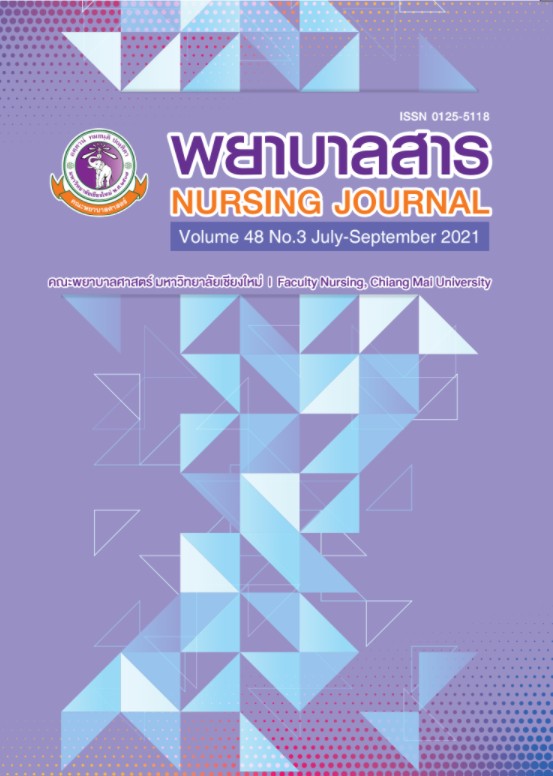ผลของกลยุทธ์หลากหลายวิธีต่อความรู้และการปฏิบัติการป้องกันการแพร่กระจายเชื้อดื้อยา ต้านจุลชีพหลายขนานในพยาบาล หอผู้ป่วยกึ่งวิกฤต โรงพยาบาลศูนย์
คำสำคัญ:
เชื้อดื้อยาต้านจุลชีพหลายขนาน, กลยุทธ์หลากหลายวิธี, ความรู้, การปฏิบัติบทคัดย่อ
เชื้อดื้อยาต้านจุลชีพหลายขนานเป็นปัญหาสำคัญทางการแพทย์ของทุกประเทศ โดยเฉพาะ
หอผู้ป่วยกึ่งวิกฤตในประเทศไทย ความรู้และการปฏิบัติตามแนวทางการป้องกันการแพร่กระจายเชื้อดื้อยาต้านจุลชีพหลายขนานในพยาบาลเป็นสิ่งที่ต้องให้ความสำคัญ การวิจัยนี้เป็นการวิจัยแบบกึ่งทดลอง
มีวัตถุประสงค์เพื่อศึกษาผลของกลยุทธ์หลากหลายวิธีต่อความรู้ และการปฏิบัติการป้องกันการแพร่กระจายเชื้อดื้อยาต้านจุลชีพหลายขนานของพยาบาล กลุ่มตัวอย่างที่ศึกษา คือ พยาบาลในหอผู้ป่วยกึ่งวิกฤต โรงพยาบาลศูนย์แห่งหนึ่ง จำนวน 26 คน ดำเนินการวิจัยตั้งแต่เดือนพฤศจิกายน 2561 ถึง กุมภาพันธ์ 2562 โดยใช้กลยุทธ์หลากหลายวิธี ประกอบด้วย การอบรมให้ความรู้ การใช้โปสเตอร์เตือน การให้ข้อมูลย้อนกลับ และการจัดหากล่องบรรจุอุปกรณ์ป้องกันส่วนบุคคลเคลื่อนที่ได้ เครื่องมือที่ใช้ในการรวบรวมข้อมูล ประกอบด้วย แบบสอบถามข้อมูลทั่วไป แบบวัดความรู้และแบบบันทึกการสังเกตการปฏิบัติ วิเคราะห์ข้อมูลโดยใช้สถิติเชิงพรรณนา สถิติทดสอบค่าที สถิติไคสแควร์ และฟิชเชอร์เอกแซคท์
ผลการศึกษาพบว่าหลังได้รับกลยุทธ์หลากหลายวิธี กลุ่มตัวอย่างมีคะแนนเฉลี่ยความรู้ในการป้องกันการแพร่กระจายเชื้อดื้อยาต้านจุลชีพหลายขนานมากกว่าก่อนได้รับกลยุทธ์หลากหลายวิธีจาก 14.85 คะแนน เพิ่มสูงขึ้นเป็น 18.08 คะแนน ซึ่งแตกต่างอย่างมีนัยสำคัญทางสถิติ (p< .01) และสัดส่วนการปฏิบัติในการป้องกันการแพร่กระจายเชื้อดื้อยาต้านจุลชีพหลายขนานที่ถูกต้อง มากกว่าก่อนได้รับกลยุทธ์หลากหลายวิธีจากร้อยละ 62.42 เป็นร้อยละ 87.13 ซึ่งแตกต่างอย่างมีนัยสำคัญทางสถิติ (p< .001)
การวิจัยนี้แสดงให้เห็นว่า กลยุทธ์หลากหลายวิธี สามารถนำไปใช้ในการส่งเสริมความรู้และการปฏิบัติการป้องกันการแพร่กระจายเชื้อดื้อยาต้านจุลชีพหลายขนานในพยาบาล หอผู้ป่วยกึ่งวิกฤตได้ ดังนั้นอาจนำกลยุทธ์หลากหลายวิธีไปใช้ในการเพิ่มความรู้และการปฏิบัติการป้องกันการแพร่กระจายเชื้อดื้อยาต้านจุลชีพหลายขนานในพยาบาลที่หอผู้ป่วยกึ่งวิกฤตแห่งอื่น
เอกสารอ้างอิง
Aboumatar, H., Ristaino, P., Davis, R. O., Thompson, C. B., Maragakis, L., Cosgrove, S., ... Perl, T. M. (2012). Infection prevention promotion program based on the PRECEDE model: Improving hand hygiene behaviors among healthcare personnel. Infection Control and Hospital Epidemiology, 33(2), 144-151. doi: 10.1086/663707
Barnes, S. L., Harris, A. D., Golden, B. L., Wasil, E. A., & Furuno, J. P. (2011). Contribution of interfacility patient movement to overall methicillin-resistant Staphylococcus aureus prevalence levels. Infection Control and Hospital Epidemiology, 32(11), 1073-1078.
Bassetti, M., Poulakou, G., Ruppe, E., Bouza, E., Van Hal, S. J., & Brink, A. (2017). Antimicrobial resistance in the next 30 years, humankind, bugs and drugs: A visionary approach. Intensive Care Medicine, 43(10), 1464-1475.
Bero, L. A., Grilli, R., Grimshaw, J. M., Harvey, E., Oxman, A. D., & Ann, M. (1998). Getting research findings into practice: Closing the gap between research and practice: An overview of systematic reviews of interventions to promote the implementation of research findings. British Medical Journal, 317(7156), 465-468.
Black, S. R., Weaver, K. N., Weinstein, R. A., Hayden, M. K., Lin, M. Y., Lavin, M. A., & Gerber, S. I. (2015). Regional infection control assessment of antibiotic resistance knowledge and practice. Infection Control and Hospital Epidemiology, 36(4), 381-386.
Cai, B., Echols, R., Magee, G., Arjona Ferreira, J. C., Morgan, G., Ariyasu, M., … Nagata, T. D. (2017). Prevalence of carbapenem-resistant gram-negative infections in the United States predominated by Acinetobacter baumannii and Pseudomonas aeruginosa. Open Forum Infections Disease, 4(3), 1-7. doi: 10.1093/ofid/ofx176
Centers for Disease Control and Prevention. (2017). Management of multidrug-resistant organisms in healthcare settings, 2006. Retrieved from: https://www.cdc.gov/infectioncontrol/guidelines/mdro/
De Freitas DalBen, M., Mendes, E. T., Moura, M. L., Rahman, D. A., Peixoto, D., dos Santos, S. A., ... Massad, E. (2016). A model-based strategy to control the spread of carbapenem-resistant Enterobacteriaceae: Simulate and implement. Infection Control and Hospital Epidemiology, 37(11), 1315-1322. doi: 10.1017/ice.2016.168
Flut, D. D. V., & Peterson, T. O. (1994). Contemporary management (3rd ed.). Boston: Houghton Miffin.
Green, L. W., & Kreuter, M. (1991). Health promotion planning an educational and environmental approach (2nd ed.). London: Mayfield.
Jacob, J. T., Klein, G. E., Laxminarayan, R., Beldavs, Z., Lynfield, R., Kallen, A. J., ... Rasheed, K. J. (2013). Vital signs: Carbapenem-resistant Enterobacteriaceae. Morbidity and Mortality Weekly Report, 62(9), 165-169.
Kasatpibal, N., Chittawatanarat, K., Nunngam, N., Kampeerapanya, D., Duangsoy, N., Sroison, U., & Rachakom, C. (in process). Development and promotion of clinical practice guidelines on prevention and control of multidrug-resistant organism transmission in surgical intensive care unit. Faculty of Nursing, Chiang Mai University. (in Thai)
Katherason, S. G., Naing, L., Jaalam, K., Mohamad, N. A. N., Bhojwani, K., Harussani, N. D. S. H., & Ismail, A. (2010). Hand decontamination practices and the appropriate use of gloves in two adult intensive care units in Malaysia. The Journal of Infection in Developing Countries, 4(02), 118-123.
Krakanna,K., Picheansathian, W., & Boonchuang, P. (2010). Effect of knowledge and practice promotional program among nurse on Methicillin-resistant Staphylococcus aureus transmission control in an Intensive care unit. Bulletin of Nosocomial Infection Control Group of Thailand, 20(3), 35-47. (in Thai)
National Antimicrobial Resistance Surveillance Center Thailand. (2018). Situation of antimicrobial resistance 2000 – 2018. (in Thai) Retrieved from: http://narst.dmsc.moph.go.th/data/AMR%202000-2018-12M.pdf
Nithedsilp, W. (2008). Instructional and innovation for learning. Pathum Thani: Skybook. (in Thai)
Onsaard, C., Klunklin, P., & Senaratana, W. (2012). Effects of the prevention and control program for methicillin- resistant Staphylococcus Aureus on knowledge and practices among nurses in neonatal intensive care unit. Nursing Journal, 39(2), 51-65. (in Thai)
Phumart, P., Phodha, T., Thamlikitkul, V., Riewpaiboon, A., Prakongsai, P., & Limwattananon, S. (2012). Health and economic impacts of antimicrobial resistant infections in Thailand: A preliminary study. Journal of Health Systems Research, 6(3), 352-360. (in Thai)
Prevention and infection control committee Prapokklao Hospital. (2017). Report surveillance of hospital-acquired infections. Department prevention and infection control in hospital Prapokklao Hospital. (in Thai)
Seibert, D. J., Speroni, K. G., Oh, K. M., DeVoe, M. C., & Jacobsen, K. H. (2014). Knowledge, perceptions, and practices of methicillin-resistant Staphylococcus aureus transmission prevention among health care workers in acute-care settings. American Journal of Infection Control, 42(3), 254-259. doi: 10.1016/j.ajic.2013.09.005
Shen, L., Wang, X., An, J., An, J., Zhou, N., Sun, L., ... Liu, X. (2017). Implementation of WHO multimodal strategy for improvement of hand hygiene: A quasi-experimental study in a Traditional Chinese Medicine Hospital in Xi’an, China. Antimicrobial Resistance and Infection Control, 6(1), 1-7. doi: 10.1186/s13756-017-0254-4
Thongcharoen, P., Moongtui, W., & Unahalekhaka, A. (2015). Effects of using multifaceted strategic method on practices of healthcare personnel in prevention of multidrug resistant bacterial Infection. Nursing Journal, 42(1), 61-73. (in Thai)
ดาวน์โหลด
เผยแพร่แล้ว
รูปแบบการอ้างอิง
ฉบับ
ประเภทบทความ
สัญญาอนุญาต
บทความที่ได้รับการตีพิมพ์เป็นลิขสิทธิ์ของวารสารพยาบาลสาร
ข้อความที่ปรากฏในบทความแต่ละเรื่องในวารสารวิชาการเล่มนี้เป็นความคิดเห็นส่วนตัวของผู้เขียนแต่ละท่านไม่เกี่ยวข้องกับมหาวิทยาลัยเชียงใหม่ และคณาจารย์ท่านอื่นๆในมหาวิทยาลัยฯ แต่อย่างใด ความรับผิดชอบองค์ประกอบทั้งหมดของบทความแต่ละเรื่องเป็นของผู้เขียนแต่ละท่าน หากมีความผิดพลาดใด ๆ ผู้เขียนแต่ละท่านจะรับผิดชอบบทความของตนเองแต่ผู้เดียว






